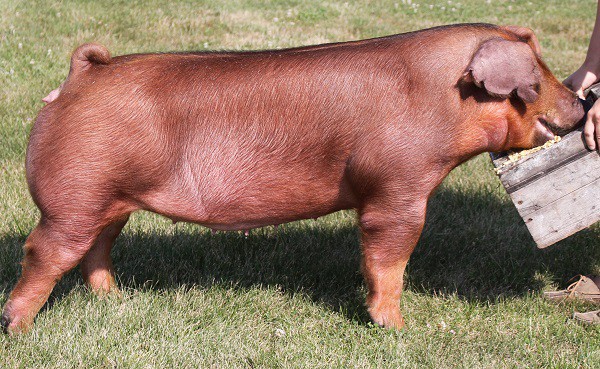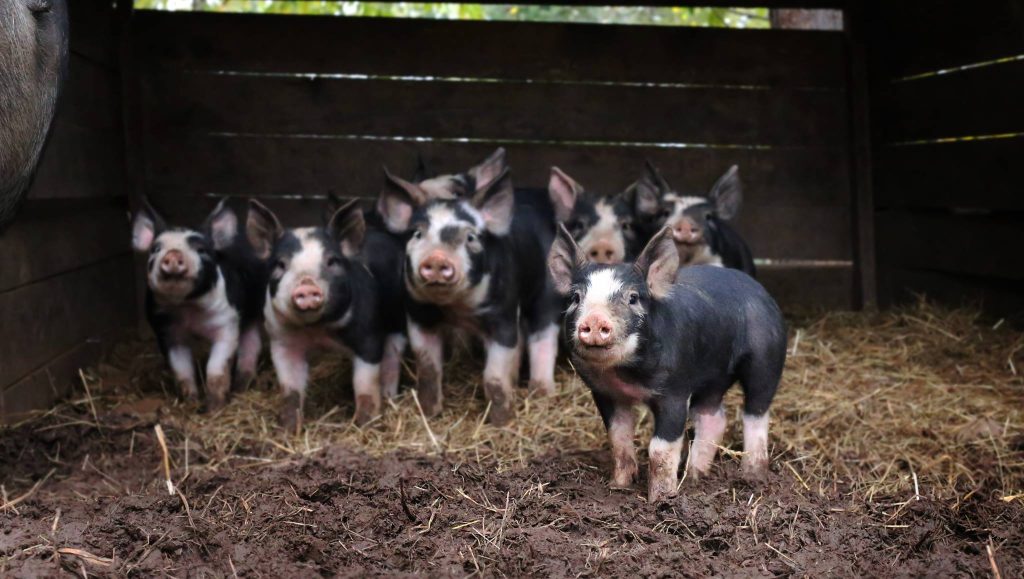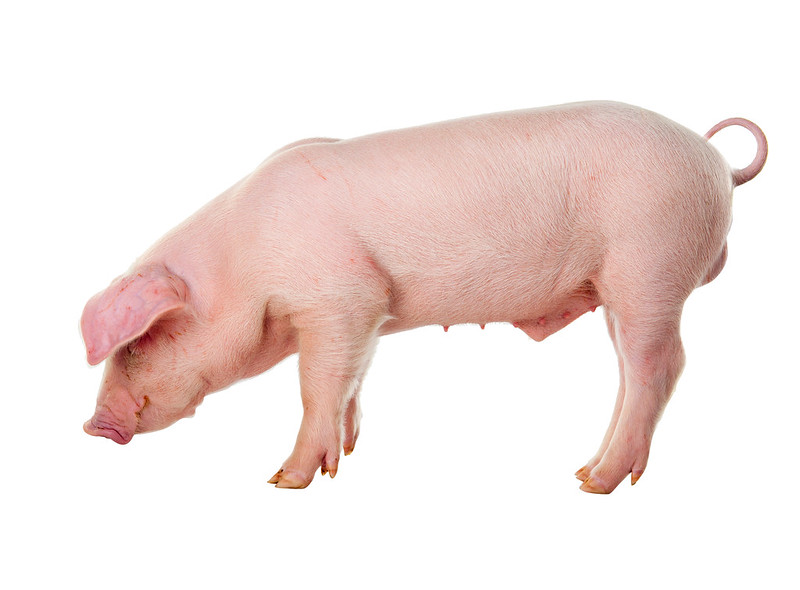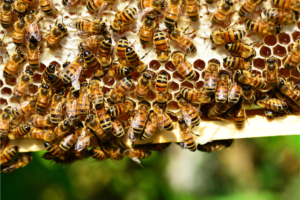Pigs have been domesticated for thousands of years, and over time, different breeds of pigs have been developed to suit various purposes such as meat production, lard, and bacon. These breeds have distinct characteristics, including size, color, coat type, and overall suitability for specific roles. In this article, we’ll look at over 40 breeds of pigs with their origin, characteristics and purpose.
Most common breeds of pigs
Among the myriad breeds of pigs that have emerged, certain breeds have gained prominence for their widespread utility and contributions to various aspects of human life. The most common breeds of pigs are;
- Yorkshire
- Duroc
- Hampshire
- Berkshire
- Landrace
1. Yorkshire

The Yorkshire pig, often referred to as the Large White, stands as one of the most iconic and recognizable breeds globally. With its impressive size, striking white coat, and erect ears, the Yorkshire has become synonymous with efficient meat production. This breed is favored for its lean meat, making it a preferred choice for commercial pork production. Renowned for its docile temperament and high carcass yield, the Yorkshire pig continues to be a cornerstone of modern swine farming.
2. Duroc

Hailing from the United States, the Duroc breed commands attention with its reddish-brown to dark-red coat and distinctive drooping ears. Beyond its aesthetics, the Duroc is celebrated for its exceptional meat quality, characterized by marbling that ensures tender, flavorful cuts. Their rapid growth and efficient feed conversion rate have led to their popularity among farmers seeking high-quality pork production. Crossbred with other breeds, Duroc genetics often elevate the overall meat quality in commercial operations.
3. Hampshire

The Hampshire breed, distinguished by its black coat adorned with a distinctive white belt, is a testament to efficient growth and meat quality. With erect ears and a reputation for rapid development, Hampshire pigs are prized for their ability to convert feed into lean, flavorful pork. This breed’s versatility has made it a go-to choice for pork enthusiasts, offering both quantity and quality in meat production.
4. Berkshire

Originating from England, the Berkshire breed boasts a striking black coat with a white face and legs. Their exquisite marbling and rich flavor profile have earned them a place of honor in the culinary world, making them a preferred choice for premium pork and bacon. Their ability to consistently deliver flavorful and tender meat has endeared them to chefs and connoisseurs alike, solidifying their status as a breed of choice for meat aficionados.
5. Landrace

Hailing from Denmark, the Landrace breed showcases its adaptability and maternal prowess. With a distinctive white coat, long body, and drooping ears, Landrace pigs excel in mothering abilities and high milk production. They’re often utilized in crossbreeding programs to enhance the survival rates and growth of piglets, making them a valuable asset for ensuring a thriving swine population.
Breeds of pigs and characteristics
1. Yorkshire
Origin: England
Characteristics: Large size, white coat, erect ears
Purpose: Meat production, lean meat, commercial pork
Notable Traits: Docile temperament, high carcass yield
2. Duroc
Origin: United States
Characteristics: Reddish-brown to dark-red coat, drooping ears
Purpose: High-quality meat, marbling, flavor
Notable Traits: Excellent meat quality, tenderness, rapid growth
3. Berkshire
Origin: England
Characteristics: Black coat, white face and legs
Purpose: Premium pork, flavorful meat, bacon
Notable Traits: Marbled meat, tenderness, rich taste
4. Hampshire
Origin: United States
Characteristics: Black coat with white belt, erect ears
Purpose: Efficient growth, meat quality
Notable Traits: Fast growth rate, lean meat, good feed conversion
5. Landrace
Origin: Denmark
Characteristics: White coat, long body, drooping ears
Purpose: Maternal traits, piglet survival, pork production
Notable Traits: High milk production, excellent mothering ability
6. Tamworth
Origin: England
Characteristics: Reddish-gold coat, long snout, erect ears
Purpose: Bacon production, outdoor environments
Notable Traits: Hardy, foraging ability, adaptability
7. Poland China
Origin: United States
Characteristics: Black coat, white face, drooping ears
Purpose: Pork production, meat quality
Notable Traits: Docile temperament, efficient growth
8. Gloucestershire Old Spot
Origin: England
Characteristics: White coat with black spots, rounded body
Purpose: Outdoor systems, heritage breed enthusiasts
Notable Traits: Friendly disposition, pasture adaptability
9. Mangalitsa
Origin: Hungary
Characteristics: Woolly coat (black, red, blonde), robust build
Purpose: High-fat content, lard production, gourmet pork
Notable Traits: Unique appearance, rich flavor
10. Pietrain
Origin: Belgium
Characteristics: Black and white-spotted coat, muscular body
Purpose: Lean meat, pork quality
Notable Traits: Muscular build, meat yield
11. Hampshire
Origin: England
Characteristics: White coat with black belt, erect ears
Purpose: Meat production, lean pork
Notable Traits: Rapid growth, efficient feed conversion
12. Middle White
Origin: England
Characteristics: Short snout, small size, white coat
Purpose: Pork production, outdoor systems
Notable Traits: Hardy, adaptable to diverse environments
13. Large Black
Origin: England
Characteristics: Black coat, long body, lop ears
Purpose: Bacon production, outdoor systems
Notable Traits: Robust build, strong foraging ability
14. Oxford Sandy and Black
Origin: England
Characteristics: Sandy-colored coat with black patches
Purpose: Pork production, outdoor systems
Notable Traits: Calm temperament, adaptable to pasture
15. Wessex Saddleback
Origin: England
Characteristics: Black coat with white saddle, lop ears
Purpose: Bacon and pork production, outdoor systems
Notable Traits: Hardy, good mothering ability
16. Meishan
Origin: China
Characteristics: Wrinkled face, floppy ears, gray coat
Purpose: Pork production, fatty meat
Notable Traits: High fat content, unique appearance
17. Choctaw Hog
Origin: United States
Characteristics: Varied coat colors, distinctive coat patterns
Purpose: Heritage conservation, pork production
Notable Traits: Resilient, adaptive to different environments
18. Kunekune
Origin: New Zealand
Characteristics: Short legs, varied coat colors, tassels
Purpose: Small-scale farming, pets
Notable Traits: Friendly disposition, suitability for small spaces
19. Belgian Landrace
Origin: Belgium
Characteristics: White coat, long body, drooping ears
Purpose: Pork production, maternal traits
Notable Traits: High milk production, good mothering ability
20. Iberian Pig
Origin: Spain, Portugal
Characteristics: Black coat, long snout, slender body
Purpose: Acorn-fed ham, gourmet pork products
Notable Traits: Exceptional flavor, marbling, high-quality meat
21. Lacombe
Origin: Canada
Characteristics: Black or red coat, drooping ears
Purpose: Pork production, lean meat
Notable Traits: Good feed efficiency, hardiness
22. Mulefoot
Origin: United States
Characteristics: Solid black coat, fused toes
Purpose: Heritage conservation, pork production
Notable Traits: Unique hoof structure, hardy
23. Swabian-Hall
Origin: Germany
Characteristics: Black coat with white belt, erect ears
Purpose: High-quality ham, pork products
Notable Traits: High marbling, meat quality
24. American Yorkshire
Origin: United States
Characteristics: White coat, erect ears
Purpose: Pork production, commercial farming
Notable Traits: Excellent growth rate, lean meat
25. Turopolje
Origin: Croatia
Characteristics: Black coat with white points, erect ears
Purpose: Pork production, hardiness
Notable Traits: Adaptable to outdoor systems, endurance
26. Bazna
Origin: Romania
Characteristics: White coat, lean build
Purpose: Pork production, meat quality
Notable Traits: Efficient feed conversion, growth rate
27. Zlotniki
Origin: Poland
Characteristics: White coat, long body, drooping ears
Purpose: Pork production, meat quality
Notable Traits: Good mothering ability, hardiness
28. Angeln Saddleback
Origin: Germany
Characteristics: Black coat with white saddle, lop ears
Purpose: Pork production, outdoor systems
Notable Traits: Strong foraging instincts, adaptability
29. Krskopolje
Origin: Slovenia
Characteristics: Black coat, white points, erect ears
Purpose: Pork production, hardiness
Notable Traits: Adaptability to harsh climates, resilience
30. Danish Protest
Origin: Denmark
Characteristics: Black coat with white points, erect ears
Purpose: Pork production, hardiness
Notable Traits: Robust build, efficient growth
31. Minzhu
Origin: China
Characteristics: Black coat with white points, erect ears
Purpose: Pork production, hardiness
Notable Traits: Thrives in various climates, adaptable
32. Poland China
Origin: United States
Characteristics: Black coat, drooping ears
Purpose: Pork production, meat quality
Notable Traits: Docile temperament, efficient growth
33. Cumberland
Origin: England
Characteristics: White coat, erect ears
Purpose: Pork production, lean meat
Notable Traits: Efficient feed conversion, adaptability
34. Choctaw
Origin: United States
Characteristics: Varied coat colors, distinctive coat patterns
Purpose: Heritage conservation, pork production
Notable Traits: Resilient, adaptive to different environments
35. Ba Xuyen
Origin: Vietnam
Characteristics: Black coat, long body, drooping ears
Purpose: Pork production, meat quality
Notable Traits: Adaptable to diverse environments, efficient growth
36. Middle White
Origin: England
Characteristics: Short snout, small size, white coat
Purpose: Pork production, outdoor systems
Notable Traits: Hardy, adaptable to different conditions
37. Welsh
Origin: Wales
Characteristics: Varied coat colors, erect ears
Purpose: Pork production, lean meat
Notable Traits: Resilient, efficient growth
38. Large Black
Origin: England
Characteristics: Black coat, lop ears
Purpose: Bacon production, outdoor systems
Notable Traits: Strong foraging ability, adaptability
39. British Lop
Origin: England
Characteristics: White coat, long body, lop ears
Purpose: Pork production, hardiness
Notable Traits: Calm temperament, maternal instincts
40. American Landrace
Origin: United States
Characteristics: White coat, drooping ears
Purpose: Pork production, maternal traits
Notable Traits: High milk production, good mothering ability
41. Mangalarga Marchador
Origin: Brazil
Characteristics: Varied coat colors, long body
Purpose: Pork and meat production
Notable Traits: Adaptability, efficient growth
42. Gascon
Origin: France
Characteristics: Black coat, erect ears
Purpose: Gourmet ham, pork products
Notable Traits: Exceptional flavor, quality meat
43. Beijing Black
Origin: China
Characteristics: Black coat, white points
Purpose: Pork production, meat quality
Notable Traits: Hardy, adaptable to different climates
44. Lacombe
Origin: Canada
Characteristics: Black or red coat, drooping ears
Purpose: Pork production, lean meat
Notable Traits: Good feed efficiency, hardiness
45. Hezuo
Origin: China
Characteristics: Black coat, erect ears
Purpose: Pork production, meat quality
Notable Traits: Efficient growth, adaptable
46. Wuzhishan
Origin: China
Characteristics: Black coat, compact size
Purpose: Pork production, hardiness
Notable Traits: Thrives in challenging conditions
47. Saddleback
Origin: United Kingdom
Characteristics: Black coat with white saddle, lop ears
Purpose: Pork production, outdoor systems
Notable Traits: Strong mothering ability, adaptability
48. Vietnamese Potbelly
Origin: Vietnam
Characteristics: Short legs, potbelly, varied coat colors
Purpose: Small-scale farming, pets
Notable Traits: Friendly disposition, small size
49. Swedish Landrace
Origin: Sweden
Characteristics: White coat, long body, drooping ears
Purpose: Pork production, meat quality
Notable Traits: Good mothering ability, efficient growth
50. French Landrace
Origin: France
Characteristics: White coat, long body, drooping ears
Purpose: Pork production, meat quality
Notable Traits: Robust build, hardiness
The bottom line
From the premium pork of the Berkshire to the hardiness of the Vietnamese Potbelly, each breed contributes its unique traits to agriculture and cuisine. Whether you’re interested in lean meat production, gourmet flavors, or heritage conservation, these 50 breeds of pigs collectively highlight the remarkable range of possibilities that pigs offer to our agricultural heritage and culinary experiences.
